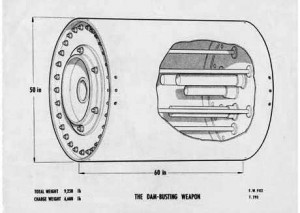- Author
- Nicholls, Bob
- Subjects
- Naval Aviation, WWII operations, History - WW2
- Tags
-
- RAN Ships
- None noted.
- Publication
- September 2010 edition of the Naval Historical Review (all rights reserved)
Those attending were so impressed that full-size trials were ordered in respect of one weapon suitable for the destruction of Germany’s dams and another smaller version for anti-shipping purposes, the latter being sponsored by the Admiralty. The model codenamed ‘Highball’ was more commonly referred to as ‘the Naval Weapon’. The principal target for Highball was the capital ships of the Kriegsmarine, with the battleship Tirpitz at the head of a list which also contained the potential threat from the two pocket battleships Scharnhorst and Gneisenau. Eliminating these ships would free the British surface fleet for future distant operations, such as those against Japan.
Wallis had demonstrated that considerably less explosive would be needed to pierce a ship’s hull than to breach a massive dam, and so two sizes of weapon were developed concurrently. By February 1943 the two weapons had been trialled with dummy models and were now ready to be tested using operational aircraft.

At this stage the Upkeep version had emerged as a cylindrical drum some 60 inches in length and with a diameter of 50 inches. It carried a charge of about 900 lb of Torpex, an improved version of TNT, being 50 percent more powerful than the original.
In contrast, the Highball had developed into a spherical weapon with a 30 inch diameter. The principal pattern of the shell gave the appearance of a gigantic golf ball, although not all seem to have been made with the same outer case. The charge was about 600 lb of Torpex. Both weapons were ignited by a hydrostatic fuse, similar to those used in naval depth charges of the time. And it is at this stage that we will leave the Dambusters and concentrate on Highball.
Until now dummy bombs had been dropped from Wellington aircraft; now it was time to transit to operational training. The original intention had been to use Beaufort fighter bomber, but the more recently introduced Mosquito had a superior performance and made it more suitable. Thus the first drop of an inert Highball was made from a Mosquito at the end of March 1943. This was to test the experimental dropping mechanism rather than the weapon, and it was successful.
As a result 618 Squadron was formed within Coastal Command of the RAF in April 1943. Its task was to sink the Tirpitz in Alten Fjord near Trondheim in Norway by using Highballs.
The next months were spent in perfecting dropping and release techniques using dummy wooden-clad weapons against a target ship Bonaventure, moored in a loch in Scotland. It was found that to achieve maximum effect a Highball had to be dropped from a height of no more than 60 feet with an aircraft speed of 360 miles per hour.
It is relevant at this juncture to describe the operation of the weapon. Two Highballs were carried in tandem in the modified bomb bay of the Mosquito with the capability of being released either singly or together. Before release the bomb was given a back spin, up to a speed of between 700 and 800 rpm. The spin was achieved by a ram air turbine.
After launch the weapon skipped across the water, travelling slightly behind the launching aircraft in order to avoid the Mosquito being caught in the detonation. On reaching the target the weapon would strike the ship’s side then sink to a depth of some 30 feet, whereupon the Mark XIV Hydrostatic Pistol would function, exploding the charge beneath or adjacent to the target hull’s bottom.
Despite delays in the delivery of the modified Mosquitoes all was ready by the end of June 1943.
Then the Germans moved the goalposts, by shifting Tirpitz north to Kaa Fjord. This was well beyond the range of the Scottish-based Mosquitoes and a sad blow to the keyed-up, highly motivated and experienced aircrew. The plan had apparently all been for nothing, and in September 1943 the squadron was disbanded with its aircraft being placed in storage and its aircrew dispersed. It seemed that this was the end of the Highball saga. Not so.
Nine months later, with the war going well in Europe and the Battle of the Atlantic, and just after the Allied landings in Normandy in June 1944, the British Joint Chiefs of Staff debated the use of the Highball system. In view of the great military and political advantages that might accrue from using Highball against the Japanese Fleet it was decided to resurrect the dormant project.




